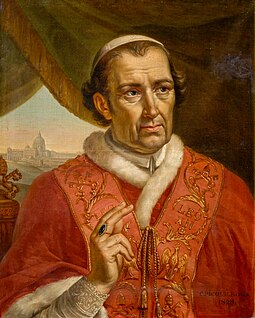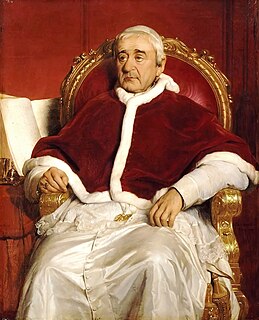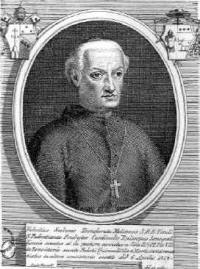
Pope Leo XII (Italian: Leone XII; born Annibale Francesco Clemente Melchiorre Girolamo Nicola della Genga, was head of the Catholic Church and ruler of the Papal States from 28 September 1823 to his death in 1829.

Pope Gregory XVI was head of the Catholic Church and ruler of the Papal States from 2 February 1831 to his death in 1846. He had adopted the name Mauro upon entering the religious order of the Camaldolese.

Fabrizio Dionigi Ruffo was an Italian cardinal and politician, who led the popular anti-republican Sanfedismo movement.

The Secretary of State of His Holiness, commonly known as the Cardinal Secretary of State, presides over the Holy See's Secretariat of State, which is the oldest and most important dicastery of the Roman Curia. The Secretariat of State performs all the political and diplomatic functions of the Holy See and the Vatican City. The Secretary of State is sometimes described as the prime minister of the Holy See, even though the nominal head of government of Vatican City is the President of the Pontifical Commission for Vatican City State.

The 1823 papal conclave was convoked following the death of Pope Pius VII on 20 August 1823. The conclave began on 2 September and ended 26 days later with the election of Cardinal Annibale Sermattei della Genga who became Pope Leo XII.

The princely House of Massimo is one of the great aristocratic families of Rome, renowned for its influence on the politics, the church and the artistic heritage of the city.
Jus exclusivae was the right claimed by several Catholic monarchs of Europe to veto a candidate for the papacy. Although never formally recognized by the Catholic Church, the French monarch, the Spanish monarch, and the Holy Roman Emperor claimed this right at various times, making known to a papal conclave, through a crown-cardinal, that the monarch deemed a particular candidate for the papacy objectionable.

Carlo Odescalchi, was an Italian prince and priest, Archbishop of Ferrara, cardinal of the Catholic Church and Vicar General of the Diocese of Rome. For years a close collaborator of popes Pius VII and Gregory XVI, in 1838 he renounced his titles in order to become a Jesuit.

Giulio Maria della Somaglia was an Italian cardinal. He was — at least in his later life — a staunch zelante cardinal who, as Secretary of State under Pope Leo XII, helped enforce an authoritarian regime in the crumbling Papal States.
The Roman Catholic Suburbicarian Diocese of Velletri–Segni is one of the suburbicarian dioceses, Catholic dioceses in Italy close to Rome with a special status and a cardinal bishop, the bishop of Velletri–Segni. Historically, the see of Velletri was combined with the see of Ostia from 1060 to 1914.

Giacomo Filippo Fransoni was an Italian prelate and cardinal who served from 1834 to 1856 as prefect of the Sacred Congregation for the Propagation of the Faith. He was the cardinal priest of the Church of San Lorenzo in Lucina at the time of his death.

San Callisto is a Roman Catholic titular church in Rome, Italy, built over the site of Pope Callixtus I's martyrdom. The original building dates from the time of Pope Gregory III, who ordered the building of a church on the site. The church has been rebuilt twice since, first in the twelfth century, and the current church in 1610. In 1458 Callixtus III decreed it a titular church as a seat for Cardinals.

Francesco Barberini, iuniore was an Italian Cardinal of the family of Pope Urban VIII (1623–1644) and of the Princes of Palestrina.

Domenico Carafa della Spina di Traetto was a Catholic Cardinal, Archbishop of Benevento and Camerlengo of the Sacred College of Cardinals.

Fabrizio Spada was an Italian Cardinal of the Roman Catholic Church, and served as Secretary of State under Pope Innocent XII.

The House of Carafa or Caraffa is a noble Neapolitan family of Italian nobles, clergy, and men of arts, known from the 12th century.

Fabrizio Paolucci was an Italian cardinal in the Roman Catholic Church, appointed by Pope Innocent XII.

Pope Pius VII created 99 cardinals in 19 consistories.

Fabrizio Sceberras Testaferrata was a native of Malta and a bishop and cardinal of the Catholic Church. He was Bishop of Senigallia from 1818 until his death in 1843.

Paul VI: The Pope in the Tempest is a 2008 Italian television movie directed by Fabrizio Costa. The film is based on real life events of Roman Catholic Pope Paul VI.
This page is based on this
Wikipedia article Text is available under the
CC BY-SA 4.0 license; additional terms may apply.
Images, videos and audio are available under their respective licenses.



















